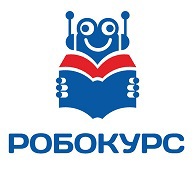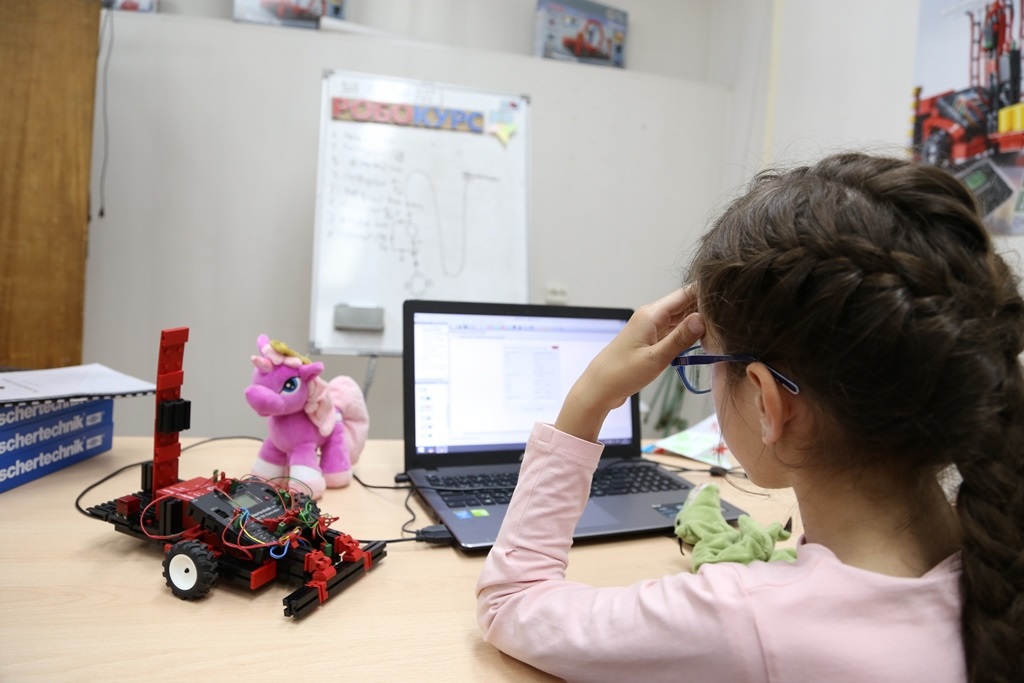Robokurs: teach children programming and robotics

As in the south, the gray-haired old man gave me advice on how to choose a watermelon. He said that one should not choose a watermelon, but a seller. While the courses of robotics are led by people, it is necessary to choose people. I know about a dozen robotics teachers from different schools and cities. I want to tell you about one circle, which I especially liked.
When I was writing material about FISCHERTECHNIK , I met wonderful people from the children's center of engineering creativity Robokurs and attended one lesson in this center. Then there were some get-togethers for tea, a conversation about old Soviet books (who remembers Programmer?), Learned a lot about the history of flowcharts (who knows what year they were invented?), About silicon valley, cybernetics and the future of education.
')
Seeing with what kind of iron the geeks-minnows were deftly controlled, a slight envy arose that they had such courses. Nothing, but we had video salons, caps and pagers. In my childhood it was a success to fasten such a motor to a piece of foam

Just on the first of September, I wanted to share something useful with readers and I bring part of my conversation with the founder and teacher of the Robocourse. What children should be taught so that they don’t get T-800 (or God forbid T-1000 ), but at least TARS .
Says Grigory Zaitsev, co-founder of the company.
Where did ROBOCOURCE come from?

I think it’s worth starting from afar — from the moment when we graduated from Bauman’s Moscow Technical Technical University and, as they say, went to real life to work in their field. However, we didn’t immediately connect to the real work. So I personally spent, probably, half a year on it in order to get acquainted with modern means of industrial automation, which were used in practice at the enterprise. I ran the tail of the engineers, delved into all the processes, got acquainted with the glands, and learned how to develop software for the controllers. Because, unfortunately, they did not give me anything of this during my studies. We had excellent training in fundamental sciences, there was a theory of automatic control, but we didn’t apply this theory anywhere in practice. As a result, I spent a lot of time - mine and my employer.
Arc steel furnace. The capacity of the furnace is 25 tons of liquid metal. We developed a management system for it.
Later, after many years, when many projects were performed in the field of industrial process automation, we, traveling around Germany, accidentally ran into FISCHERTECHNIK designers. It was some kind of exhibition of models collected by enthusiasts, and my attention was attracted by the layout of the rolling mill. At that moment, something clicked in my head, and as a result, an idea emerged - to combine models from designers and industrial controllers to form a single complex for workshops on industrial automation. The path to the realization of this idea was difficult and not as fast as it was wanted.
At some point, when we were already actively engaged in the distribution of FISCHERTECHNIK engineering designer, we were asked questions: “You have good designers in beautiful boxes, you even translated instructions for them into Russian, but how to work with them? How to organize the educational process with their help? ". At first, we naively hoped that someone would be inspired and develop the author's method, the author's course on the use of our designers, but after a while we realized that we would have to do everything ourselves. We decided to make a pilot site where you could demonstrate how to work with FISCHERTECHNIK designers. Hung up an ad and began to develop a technique.
What is the program Robokurs?
First of all, Robokurs is a program of studies. In total, we have developed 25 classes, grouped into 5 courses.
The first two courses are introductory. We will find out what robots are, how they differ from those robots that are found in movies and computer games, find out what robots we will build. We get acquainted with the basics of design, collect simple models, connect to a computer, learn to create algorithms to manage the assembled models. All models are associated with real life. Not cyborgs, dinosaurs, birds, crocodiles, but real things - a traffic light, a barrier, a washing machine, an automatic press. During one lesson, the child manages to assemble a model, program it and show the result to the parents.
The third course . It differs significantly from the first two in that we no longer have instructions for assembling models. At the first lesson, children receive the same task for everyone, but each one solves the problem independently. Also, to solve the problem of the third course is required to develop a user interface for its own management system. The fact is that our “client”, who ordered the development, is very far from programming and does not understand anything in flowcharts. Therefore, we need to make the management convenient and understandable.
Work on the project goes on for five sessions, and then the project’s “defense” takes place. To do this, we study the algorithm for protecting projects: how to present your project, what to tell, how to interact with the audience, how to answer questions, what to do if there is no answer to the question. We invite parents to protection, and in front of the entire audience children protect their projects.
The fourth course is dedicated to mobile robot control technology. Now the models begin to move in space. First, we build the base carriage, install the controller on it and learn to control the robot so that it moves along the desired route. First we use timers to measure the distance traveled, but over time we observe that the timer does not provide the desired control accuracy. This is due to the fact that the motors have different characteristics. And the trajectory often does not coincide with the desired route. We go to the left of a deeper and understand what is inside the toy motor. It turns out that there are special pulse sensors - encoders, with which you can measure the number of revolutions of the motor. These sensors can be used to synchronize the rotation of the wheels. We are moving from using timers to encoders. As a result, by the fifth lesson of the fourth year our robot always comes exactly to the specified point.

In the fifth year, we equip the robot with optical sensors and learn to develop programs and algorithms to control the robot that moves along the line. Before that, we meet with these industrial transport robots, which ride the warehouse and move goods, using as a guide the magnetic field of the conductor, which lies under the floor. In our projects, instead of a magnetic field, we use a black line. Thus, we have a feedback system. To solve the problem, children develop an algorithm that implements a simple relay controller. As a result, by the fifth lesson, our robot deftly runs along the line. The fifth course is completed, what to do next? The correct answer is to participate in competitions or creative projects.
Final part
In general, our task (Robokurs) is to get children interested in designing themselves, to show that this is not very difficult. Our peculiarity is that the authors of the curriculum are engineers with extensive experience in industry. And we used all our engineering experience for the preparation of the training program.
For example, in one of the classes we collect an industrial forge. In his security system uses the so-called two-handed control, when the worker must necessarily use two hands to start the press. So that there is no free hand that can be accidentally pressed by the mechanism. We repeat this circuit and supplement it with a light barrier that uses a phototransistor. It turns out a two-tier security system.
Our methodology is developed taking into account the fact that the constructor is a limited resource. It can not be occupied for a long time, because if we occupied the designer for one project, then for another we would need to purchase another set. To prevent this from happening, we selected models for assembly in the classroom so that the children could assemble the structure, compile and test the control algorithm, and then disassemble the model in one lesson. This ensures a rational use of resources and significantly reduces costs.
Any person or organization can contact us for advice on how to open their own Robocourses as a franchise . To do this, we have a methodology, all the necessary equipment and an automated CRM system for managing occupations.
Contacts
If you have a little boy of 7-13 years old, then you should be here.
Site - robokurs.ru
Group - vk.com/robo_kurs
Source: https://habr.com/ru/post/366295/
All Articles